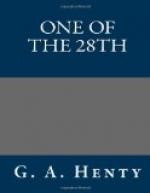The position was a singular one; and had Napoleon ordered his infantry to advance in the rear of the cavalry, the issue of the day might have been changed. In appearance the French were masters of the position. Their masses of cavalry hid the British squares from sight. The British cavalry were too weak to charge, and most of the guns were in the possession of the French; but the latter’s infantry were far away, and after sustaining the fire of the squares for a long time, the cavalry began to draw off. Lord Uxbridge now endeavored to persuade the Cumberland Hanoverian Hussars, who had not so far been engaged, to charge; but instead of obeying orders they turned and rode off, and never drew bridle until they reached Brussels, where they reported that the British army had been destroyed.
Adams’ brigade were now brought up from the reserve, and drove back the French infantry and cavalry who had come up to the top of the crest beyond Hougoumont. On the other side Ney sent a column against La Haye Sainte. The Germans made a gallant stand; but they were cut off from all assistance, outnumbered, and were altogether without ammunition; and although they defended themselves with their bayonets to the end, they were slain almost to a man, and La Haye Sainte was captured at last. But beyond this the French could not advance; and though column after column moved forward to the attack on the crest, they were each and all beaten back.
It was now nearly seven o’clock in the evening, and the Prussians were engaged at St. Lambert, Napoleon having detached Lobau’s corps to arrest their progress. Their march had been a terrible one. They had to traverse country roads softened by the rain; the men were up to their ankles in mud, guns and carriages stuck fast, and it was not until after tremendous efforts that the leading squadron of their cavalry passed through the wood of Wavre and came in view of the battle that was raging. It was then past four o’clock, and another hour passed before any considerable number of infantry arrived. It was at this time Napoleon sent Lobau against them. He was able for a time to resist their advance; but as fresh troops came up from the rear the Prussians began to win their way forward, and Napoleon was obliged to send two more divisions of the Young Guard to check them.
He now saw that all was lost unless he could, before the whole of the Prussian army arrived, break down the resistance of the British. He therefore prepared for a final effort. Ney was to collect all his infantry, and, advancing past La Haye Sainte, to fall upon the center of the British line. The guard, who had hitherto been held in reserve, was to pass Hougoumont and attack the left center. The cavalry were to follow in support.
A cannonade even more heavy and terrible than before, for the guns of the reserve had been brought up, opened upon the British, and the squares were now melting away fast. But no reinforcements could be sent to them, for the whole of the British troops were now in action, and their allies had for the most part long before left the field.




